Discover 35 hidden attractions, cool sights, and unusual things to do in Glasgow (United Kingdom). Don't miss out on these must-see attractions: Kelvingrove Art Gallery and Museum, Riverside Museum, and Gallery of Modern Art. Also, be sure to include Burrell Collection in your itinerary.
Below, you can find the list of the most amazing places you should visit in Glasgow (Scotland).
Table of Contents
Kelvingrove Art Gallery and Museum
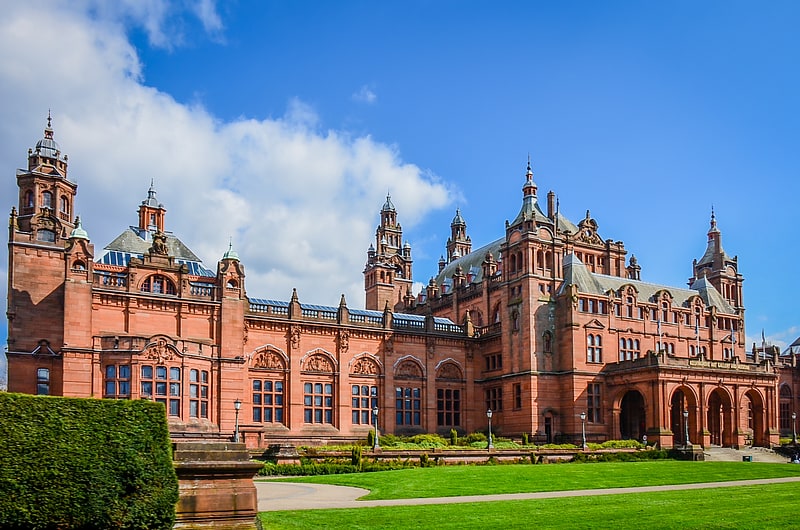
Grand building of art and natural history. Kelvingrove Art Gallery and Museum is a museum and art gallery in Glasgow, Scotland. It reopened in 2006 after a three-year refurbishment and since then has been one of Scotland's most popular visitor attractions. The museum has 22 galleries, housing a range of exhibits, including Renaissance art, taxidermy, and artifacts from ancient Egypt.[1]
Address: Argyle St, G3 8AG Glasgow (West End)
Riverside Museum
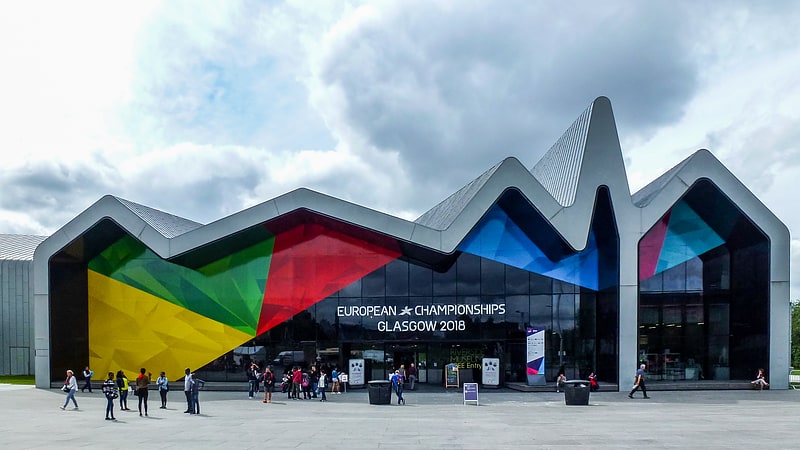
The Riverside Museum is the location of the Glasgow Museum of Transport, at Pointhouse Quay in the Glasgow Harbour regeneration district of Glasgow, Scotland. The building opened in June 2011. The museum won the 2013 European Museum of the Year Award.[2]
Address: Riverside Museum 100 Pointhouse Place, G3 8RS Glasgow (West End)
Gallery of Modern Art

Art gallery in Glasgow, Scotland. The Gallery of Modern Art is the main gallery of contemporary art in Glasgow, Scotland.
GoMA offers a programme of temporary exhibitions and workshops. GoMA displays work by local and international artists as well as addressing contemporary social issues through its major biannual projects.[3]
Address: 111 Queen Street, G1 3AH Glasgow (City Centre)
Burrell Collection
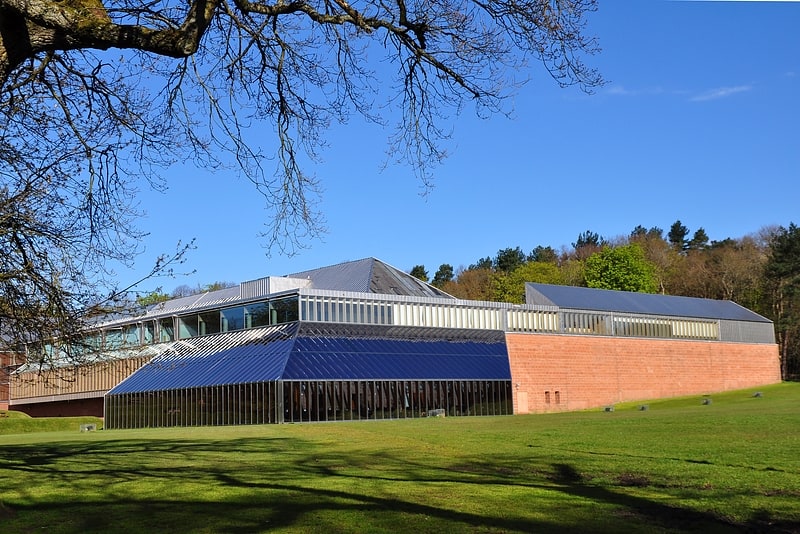
Specialist museum of art and artifacts. The Burrell Collection is a museum in Glasgow, Scotland, managed by Glasgow Museums. It houses the internationally significant art collection of Sir William Burrell and Constance, Lady Burrell. The museum reopened on the 29 March 2022 with free entry, and to extremely positive media reaction,. having been closed for refurbishment since 23 October 2016.[4]
Address: 2060 Pollokshaws Road, G43 1AT Glasgow (South Side)
People's Palace
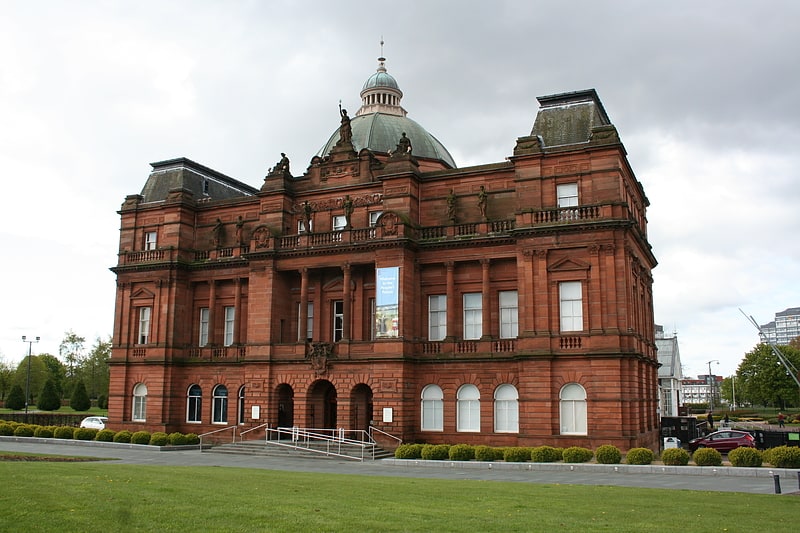
Museum in Glasgow, Scotland. The People's Palace and Winter Gardens in Glasgow, Scotland, is a museum and glasshouse situated in Glasgow Green, and was opened on 22 January 1898 by The 5th Earl of Rosebery.[5]
Address: Glasgow Green, G40 1AT Glasgow (East End)
Glasgow University Union
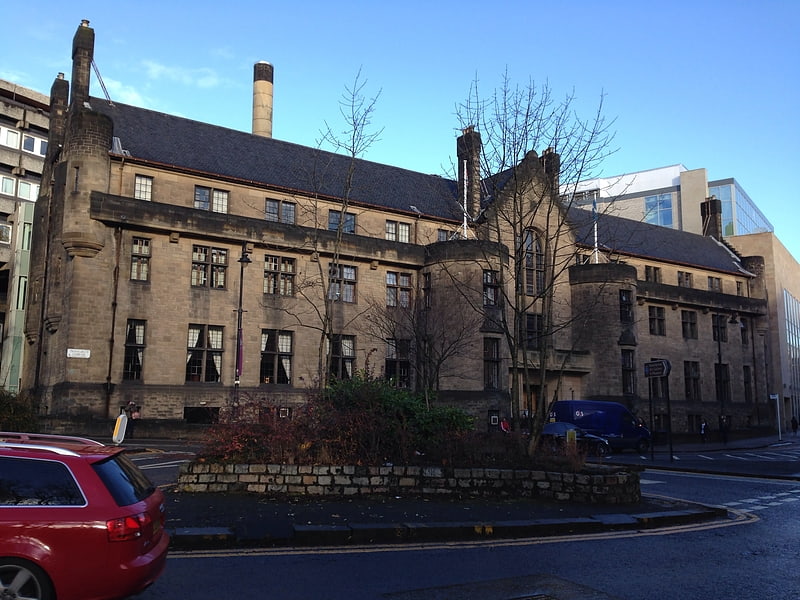
Glasgow University Union is one of the largest and oldest students' unions in the UK, serving students and alumni of the University of Glasgow since 1885.
The GUU organises social affairs for its members, provides catering and entertainment. Students are eligible to become members for free at any point throughout their University career and alumni may become Life Members by applying to the Board of Management.[6]
Address: 32 University Avenue, Glasgow (West End)
St Mungo Museum of Religious Life & Art
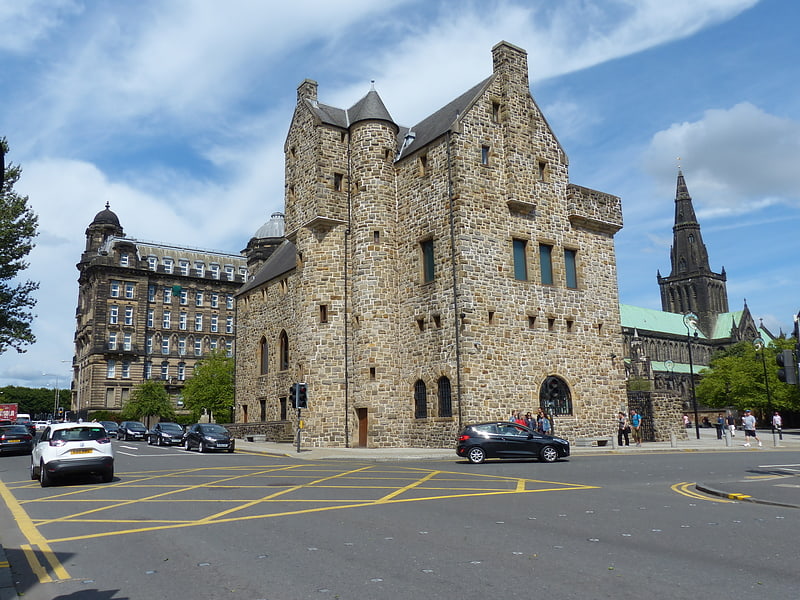
Museum in Glasgow, Scotland. The St Mungo Museum of Religious Life and Art is a museum of religion in Glasgow, Scotland. It has been described as the only public museum in the world devoted solely to this subject, although other notable museums of this kind are the State Museum of the History of Religion in St. Petersburg and the Catharijneconvent in Utrecht.[7]
Address: 2 Castle Street, G4 0RH Glasgow (City Centre)
Pollok House
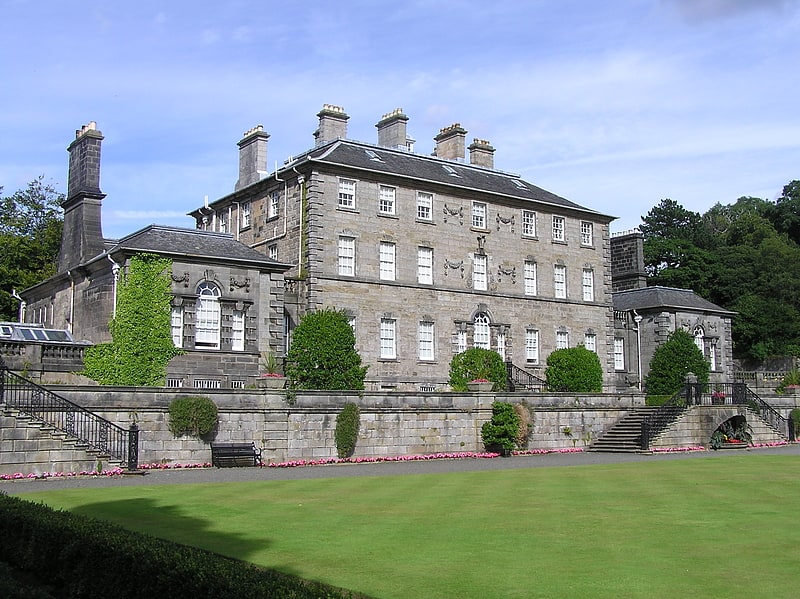
Pollok House, formerly the family seat of the Stirling-Maxwell family, is located at Pollok Country Park in Glasgow, Scotland.[8]
Address: Pollok Country Park 2060 Pollokshaws Road, G43 1AT Glasgow (South Side)
Hampden Park
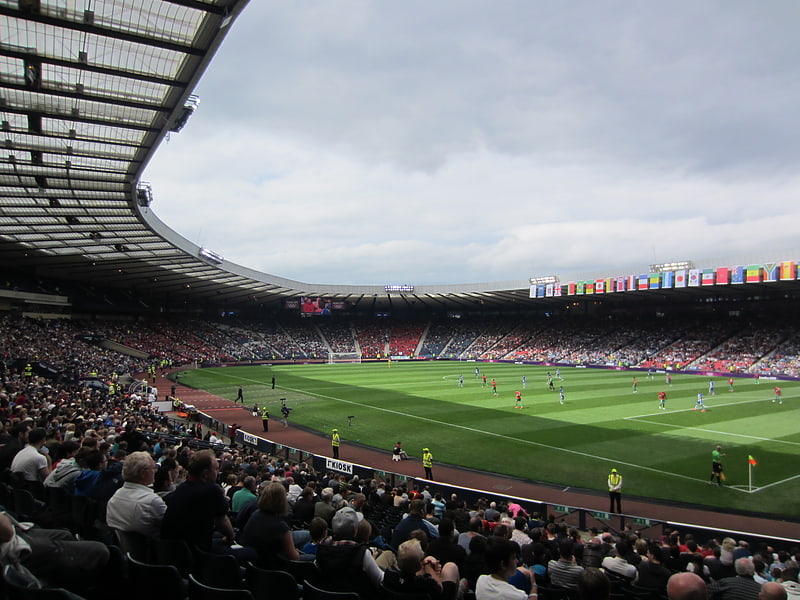
Stadium in Glasgow, Scotland. Hampden Park is a football stadium in the Mount Florida area of Glasgow, Scotland. The 51,866-capacity venue serves as the national stadium of football in Scotland. It is the normal home venue of the Scotland national football team and was the home of club side Queen's Park for over a century. Hampden regularly hosts the latter stages of the Scottish Cup and Scottish League Cup competitions and has also been used for music concerts and other sporting events, such as when it was reconfigured as an athletics stadium for the 2014 Commonwealth Games.
There were two 19th-century stadia called Hampden Park, built on different sites. A stadium on the present site was first opened on 31 October 1903. Hampden was the biggest stadium in the world when it was opened, with a capacity in excess of 100,000. This was increased further between 1927 and 1937, reaching a peak of 150,000. The record attendance of 149,415, for a Scotland v England match in 1937, is the European record for an international football match. Tighter safety regulations meant that the capacity was reduced to 81,000 in 1977. The stadium has been fully renovated since then, with the most recent work being completed in 1999.
The stadium houses the offices of the Scottish Football Association (SFA) and Scottish Professional Football League (SPFL). Hampden has hosted prestigious sporting events, including three European Cup / Champions League finals, two Cup Winners' Cup finals and a UEFA Cup final. Hampden is a UEFA category four stadium and it is served by the nearby Mount Florida and King's Park railway stations.[9]
Address: Hampden Park Letherby Drive, G42 9BA Glasgow (South Side)
Glasgow School of Art

Higher education in Glasgow, Scotland. The Glasgow School of Art is a higher education art school offering undergraduate degrees; post-graduate awards and PhDs in architecture, fine art and design based in Glasgow, Scotland.
The school is housed in a number of buildings in the centre of Glasgow, upon Garnethill, an area first developed by William Harley of Blythswood Hill in the early 1800s. The most famous of its buildings was designed by Charles Rennie Mackintosh in phases between 1896–1909. The eponymous Mackintosh Building soon became one of the city's iconic landmarks and stood for over 100 years. It is an icon of the Modern Style (British Art Nouveau style). The building was severely damaged by fire in May 2014 and destroyed by a second fire in June 2018, with only the burnt-out shell remaining.
In 2022, GSA was placed 11th in the QS World Rankings for Art and Design, dropping from its 8th place ranking held for the previous 3 years. Despite its high ranking in selected league tables Glasgow School of Art has recently scored poorly for the quality of its student experience in the annual National Student Survey. In 2019 it had the lowest student satisfaction of an Higher Education provider in Scotland and in 2020 and 2021 it was the the lowest in the UK.[10]
Address: 167 Renfrew Street, G3 6RQ Glasgow (City Centre)
The Lighthouse
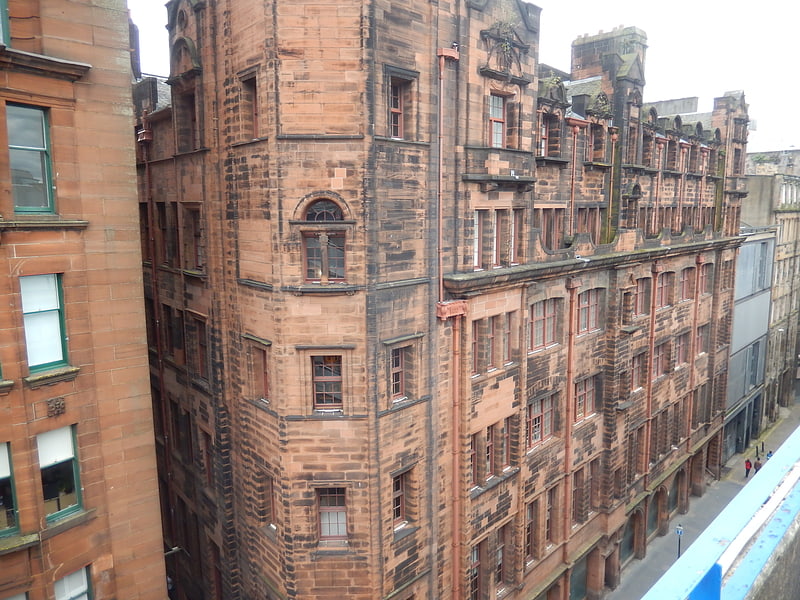
Historical landmark in Glasgow, Scotland. The Lighthouse in Glasgow is Scotland's Centre for Design and Architecture. It was opened as part of Glasgow's status as UK City of Architecture and Design in 1999.
The Lighthouse is the renamed conversion of the former offices of the Glasgow Herald newspaper. Completed in 1895, it was designed by the architect Charles Rennie Mackintosh. The centre's vision is to develop the links between design, architecture, and the creative industries, seeing these as interconnected social, educational, economic and cultural issues of concern to everyone.[11]
Address: 11 Mitchell Ln, G1 3NU Glasgow (City Centre)
Glasgow Necropolis
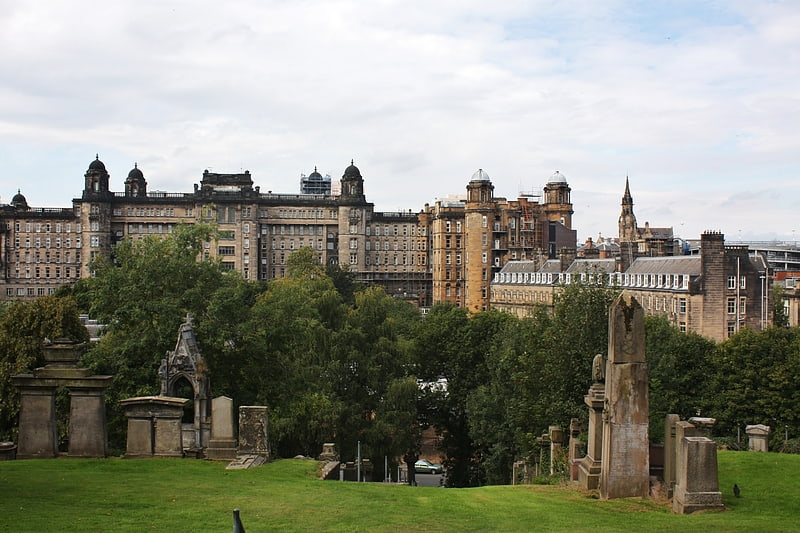
Cemetery in Glasgow, Scotland. The Glasgow Necropolis is a Victorian cemetery in Glasgow, Scotland. It is on a low but very prominent hill to the east of Glasgow Cathedral. Fifty thousand individuals have been buried here. Typical for the period, only a small percentage are named on monuments and not every grave has a stone. Approximately 3,500 monuments exist here.[12]
Address: 50 Cathedral Square, G4 0UZ Glasgow (East End)
Ibrox Stadium
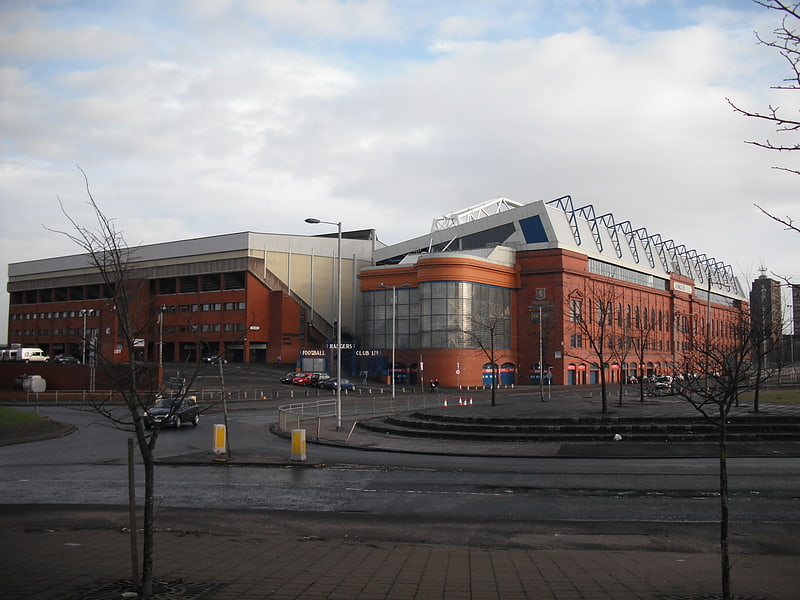
Stadium in Glasgow, Scotland. Ibrox Stadium is a football stadium on the south side of the River Clyde in the Ibrox area of Glasgow, Scotland. The home of Rangers Football Club, Ibrox is the third largest football stadium in Scotland, with an all-seated capacity of 50,817.
Opened as Ibrox Park in 1899, it suffered a disaster in 1902 when a wooden terrace collapsed. Vast earthen terraces were built in its place, and a main stand, now a listed building, in 1928. A British record crowd of 118,567 gathered in January 1939 for a league match with Celtic. After the Ibrox disaster of 1971, the stadium was largely rebuilt. The vast bowl-shaped terracing was removed and replaced by three rectangular, all-seated stands by 1981. After renovations were completed in 1997, the ground was renamed Ibrox Stadium.
Ibrox hosted the Scotland national football team when Hampden Park was redeveloped in the 1990s, and three Scottish cup finals in the same period, and has also been a concert venue.
Ibrox Stadium has been involved in two major tragedies. On 5 April 1902, the 1902 Ibrox disaster occurred when 25 people were killed and more than 500 were injured when heavy rainfall the previous night caused part of the West Tribune Stand (now Broomloan Road Stand) at Ibrox Park (now Ibrox Stadium) to collapse, causing 200 to 300 people to fall onto the concrete below during an international association football match between Scotland and England as part of the 1901–02 British Home Championship. On 2 January 1971, the 1971 Ibrox disaster occurred when a crush among Rangers supporters at an Old Firm game led to 66 deaths and more than 200 injuries after the collapse of stairway barriers occurred; a fan fell as the crowd was leaving the stadium, resulting in the fatal crush on an exit stairway (Stairway 13) at the far corner of the Copland Road Stand at Ibrox Park (now Ibrox Stadium). It was the worst British football disaster until the Hillsborough disaster in Sheffield, England, in 1989.[13]
Address: Ibrox Stadium 150 Edmiston Drive, G51 2XD Glasgow (South Side)
Hunterian Museum and Art Gallery

Scotland’s oldest public museum. The University of Glasgow's museum dedicated to William Hunter is the oldest museum in Scotland. It covers the Hunterian Museum, the Hunterian Art Gallery, the Mackintosh House, the Zoology Museum and the Anatomy Museum, all located in various buildings on the main campus of the University in the west end of Glasgow.[14]
Address: Glasgow University, G12 8QQ Glasgow (West End)
Silverburn Shopping Centre
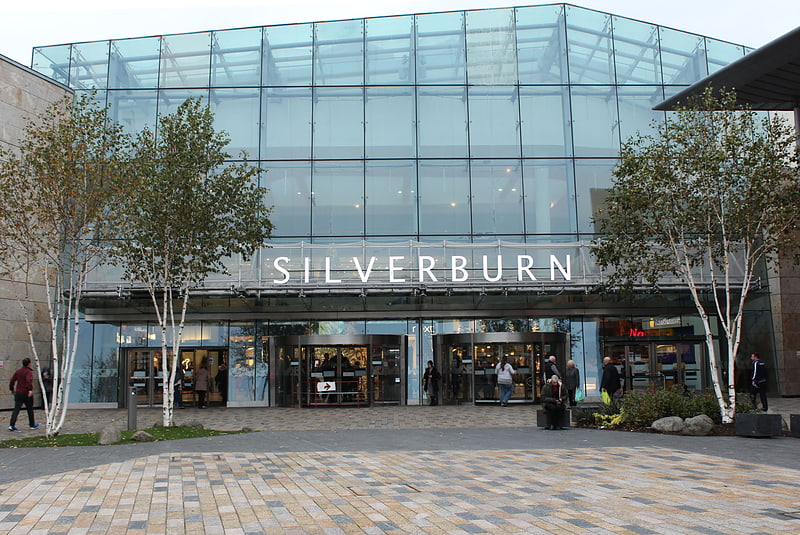
Shopping centre in Glasgow, Scotland. Silverburn is an out-of-town shopping centre located on Barrhead Road in Pollok, Glasgow, Scotland. The development replaces the 75-acre Pollok centre with a brand new 1,500,000-square-foot shopping centre, anchored by Tesco, Next, Marks & Spencer and previously Debenhams before it closed in 2021.[15]
Address: 751 Barrhead Road, G53 6AG Glasgow
House for an Art Lover
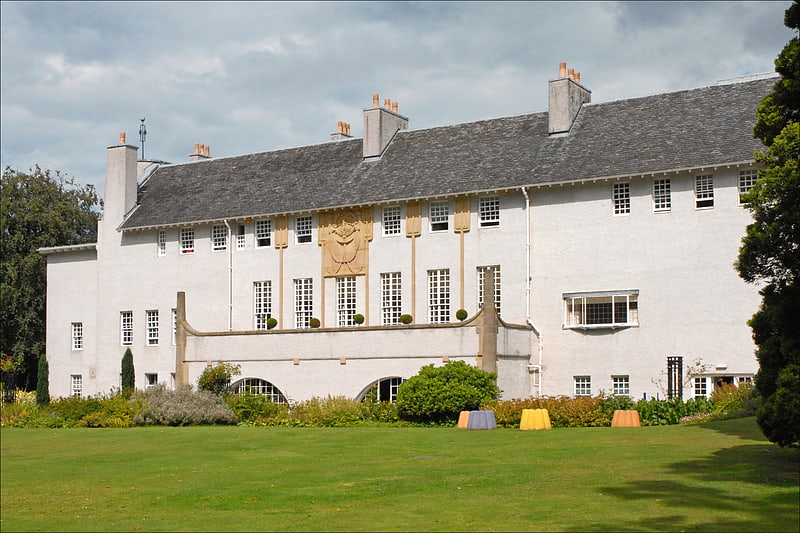
Building in Glasgow, Scotland. The House for an Art Lover is a building constructed between 1989 and 1996 and based on a 1901 design by Charles Rennie Mackintosh with his wife, Margaret MacDonald. The building is situated in Bellahouston Park in Glasgow, Scotland and sits east of the site of the famed Festival Tower of the Empire Exhibition, Scotland of 1938. The idea to actually construct the house from the Mackintoshs' designs came from Graham Roxburgh, a civil engineer in Glasgow who had done refurbishment work on the Mackintosh interiors in Craigie Hall. The house is a prominent example of the Modern Style. The house is a venue for art exhibitions and other events, as well as being itself a visitor attraction.[16]
Address: 10 Dumbreck Rd, G41 5BW Glasgow (South Side)
Glasgow Science Centre
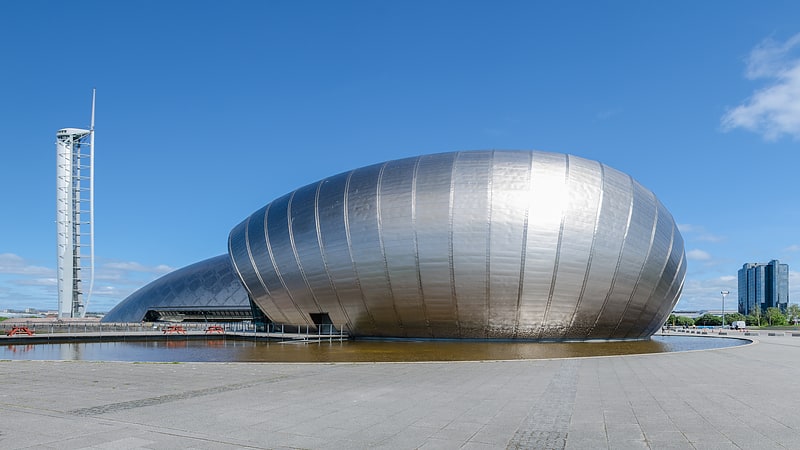
Hands-on science and technology exhibits. Glasgow Science Centre is a visitor attraction located in the Clyde Waterfront Regeneration area on the south bank of the River Clyde in Glasgow, Scotland. Queen Elizabeth II opened Glasgow Science Centre on 5 July 2001. It is one of Scotland's most popular paid-for visitor attractions. It is a purpose-built science centre composed of three principal buildings: Science Mall, Glasgow Tower and an IMAX cinema. It is a registered charity under Scottish law.
The Scottish tourist board, VisitScotland, awarded Glasgow Science Centre a five star rating in the visitor attraction category.
As well as its main location, Glasgow Science Centre also manages the visitor centre at Whitelee Wind Farm, which opened to the public in 2009.[17]
Address: 50 Pacific Quay, G51 1EA Glasgow (South Side)
Glasgow Green
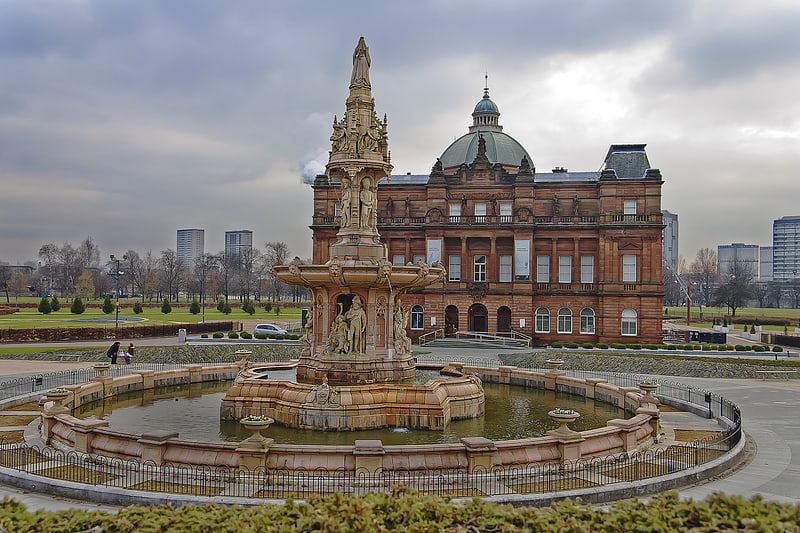
Park in Glasgow, Scotland. Glasgow Green is a park in the east end of Glasgow, Scotland, on the north bank of the River Clyde. Established in the 15th century, it is the oldest park in the city.[18]
Queen's Cross Church
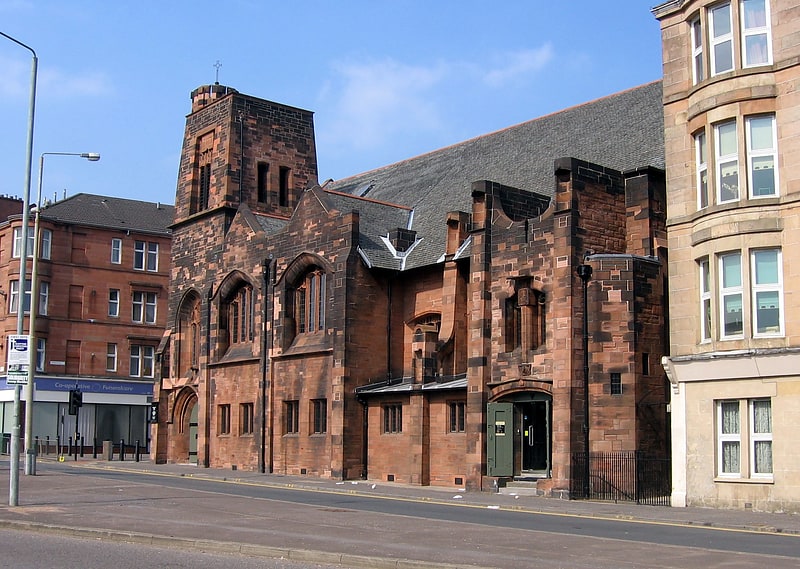
Queen's Cross Church is a former Church of Scotland parish church in Glasgow, Scotland. It is the only church designed by Charles Rennie Mackintosh to have been built; hence, it is also known as The Mackintosh Church.[19]
Address: 870 Garscube Rd, G20 7EL Glasgow
George Square
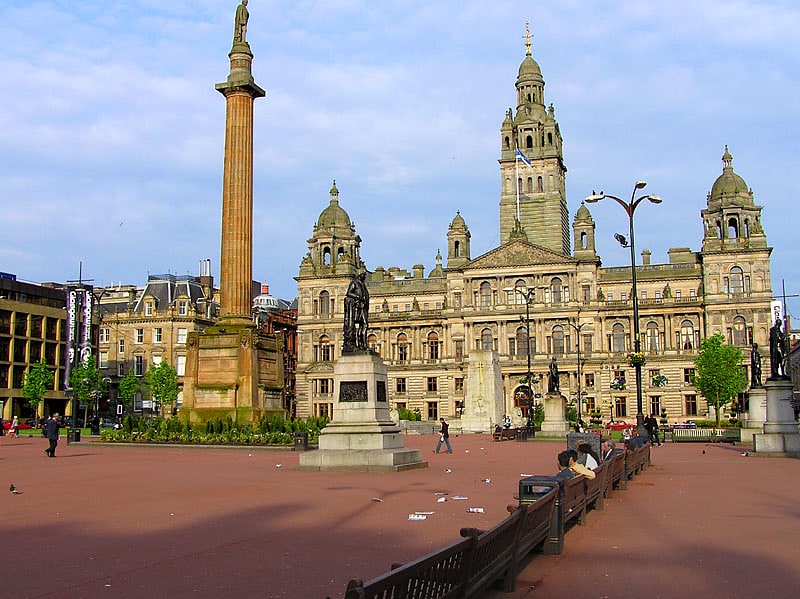
Building in Glasgow, Scotland. George Square is the principal civic square in the city of Glasgow, Scotland. It is one of six squares in the city centre, the others being Cathedral Square, St Andrew's Square, St Enoch Square, Royal Exchange Square, and Blythswood Square on Blythswood Hill.
Named after King George III and initially laid out in 1781 but not developed for another twenty years, George Square is surrounded by architecturally important buildings including on the east side the palatial Municipal Chambers, also known as the City Chambers, whose foundation stone was laid in 1883, and on the west side by the Merchants' House. Built by Glasgow Corporation, the Chambers are the continuing headquarters of Glasgow City Council. Joseph Swan's panoramic engraving of 1829 shows the early development of the square and its surrounding buildings.
The square boasts an important collection of statues and monuments, including those dedicated to Robert Burns, James Watt, Sir Robert Peel and Sir Walter Scott.[20]
Address: George and St. Vincent Sts., Glasgow (City Centre)
Braehead Arena
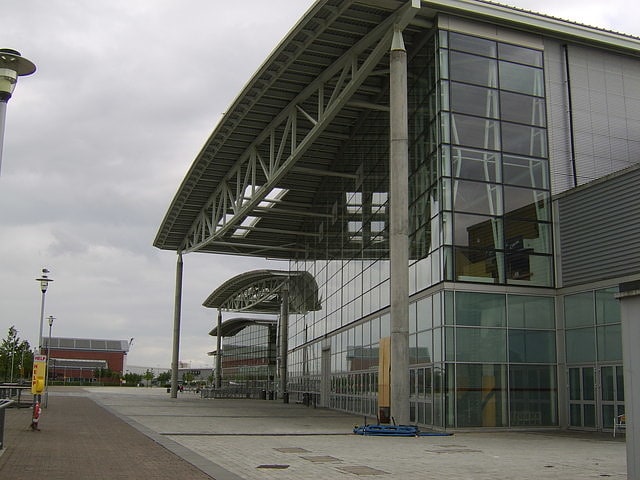
Arena in Renfrew, Scotland. The Braehead Arena is a multi-purpose arena in Renfrewshire, Scotland. The arena was built in 1999, and is located within the Braehead Complex. The arena was formerly the home of the Scottish Eagles ice hockey club and is now the home to the expansion Glasgow Clan ice hockey team of the Elite Ice Hockey League.
From 2002 to 2008, Braehead Arena was home to Scotland's only professional basketball team, the Scottish Rocks.[21]
Address: King's Inch Road, G51 4BN Glasgow
Forth and Clyde Canal
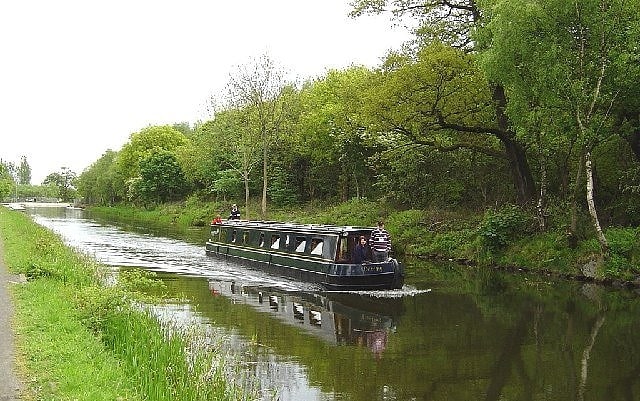
Canal in Scotland. The Forth and Clyde Canal is a canal opened in 1790, crossing central Scotland; it provided a route for the seagoing vessels of the day between the Firth of Forth and the Firth of Clyde at the narrowest part of the Scottish Lowlands. This allowed navigation from Edinburgh on the east coast to the port of Glasgow on the west coast. The canal is 35 miles long and it runs from the River Carron at Grangemouth to the River Clyde at Bowling, and had an important basin at Port Dundas in Glasgow.
Successful in its day, it suffered as the seagoing vessels were built larger and could no longer pass through. The railway age further impaired the success of the canal, and in the 1930s decline had ended in dormancy. The final decision to close the canal in the early 1960s was made due to maintenance costs of bridges crossing the canal exceeding the revenues it brought in. However, subsidies to the rail network were also a cause for its decline and the closure ended the movement of the east-coast Forth River fishing fleets across the country to fish the Irish Sea. The lack of political and financial foresight also removed a historical recreational waterway and potential future revenue generator to the town of Grangemouth. Unlike the majority of major canals the route through Grangemouth was drained and backfilled before 1967 to create a new carriageway for port traffic.
The M8 motorway in the eastern approaches to Glasgow took over some of the alignment of the canal, but more recent ideas have regenerated the utility of the canal for leisure use.[22]
Glasgow Botanic Gardens

Park with tropical plants in glasshouse. Glasgow Botanic Gardens is a botanical garden located in the West End of Glasgow, Scotland. It features several glasshouses, the most notable of which is the Kibble Palace.
The Gardens has a wide variety of temperate and tropical flora, a herb garden, a chronological bed with plants arranged according to their introduction to Scotland, the UK's national collection of tree ferns, and a world rose garden officially opened in 2003 by Princess Tomohito of Mikasa.
The River Kelvin runs along the north side of the Gardens and continues through Kelvingrove Park, the Kelvin walkway providing an uninterrupted walking route between the two green spaces.
The Botanic Gardens was awarded a Green Flag Award in 2011.[23]
Address: 730 Great Western Road, G12 0UE Glasgow
Glasgow Cathedral
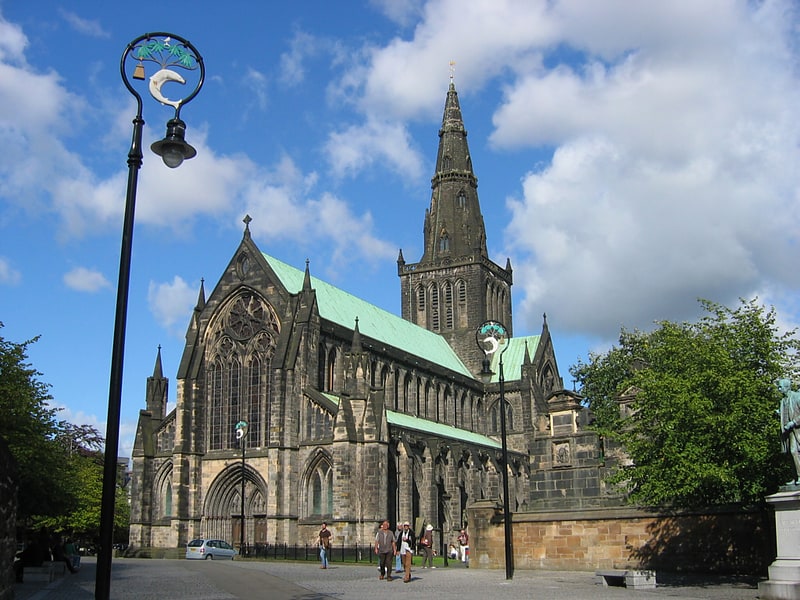
Medieval edifice with ornate windows. Glasgow Cathedral is a parish church of the Church of Scotland in Glasgow, Scotland. It is the oldest cathedral in mainland Scotland and the oldest building in Glasgow. The cathedral was the seat of the Archbishop of Glasgow, and the mother church of the Archdiocese of Glasgow and the Province of Glasgow, until the Scottish Reformation in the 16th century. Glasgow Cathedral and St Magnus Cathedral in Orkney are the only medieval cathedrals in Scotland to have survived the Reformation virtually intact.
The cathedral is dedicated to Saint Mungo, the patron saint of Glasgow, whose tomb lies at the centre of the building's Lower Church. The first stone cathedral was dedicated in 1136, in the presence of David I. Fragments of this building have been found beneath the structure of the present cathedral, which was dedicated in 1197, although much of the present cathedral dates from a major rebuilding in the 13th century. Following its foundation in 1451, the University of Glasgow held its first classes within the cathedral's chapter house. After the Reformation, Glasgow Cathedral was internally partitioned to serve three separate congregations (Inner High, Outer High and Barony). The early 19th century saw a growing appreciation of the cathedral's medieval architecture, and by 1835 both the Outer High and Barony congregations had moved elsewhere in the city, allowing the restoration of the cathedral to something approaching its former glory.
Glasgow Cathedral has been Crown property since 1587. The entire cathedral building passed into the care of the state in 1857, and today it is the responsibility of Historic Environment Scotland. The congregation is today part of the Church of Scotland's Presbytery of Glasgow.[24]
Address: Castle St, G4 0QZ Glasgow (City Centre)
Glasgow Museum of Transport
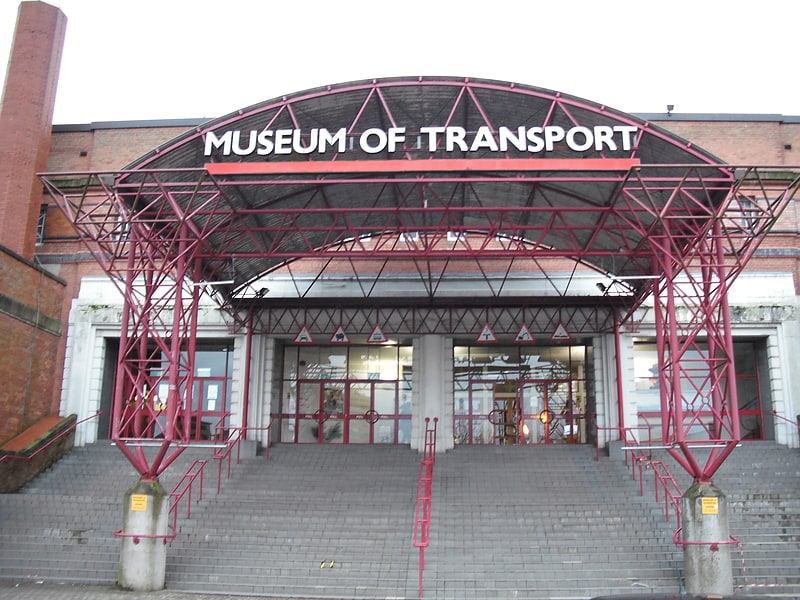
Museum. The Glasgow Museum of Transport in Glasgow, Scotland was established in 1964 and initially located at a former tram depot in Pollokshields. In 1988 the museum was relocated to the city's Kelvin Hall, then moved to its current location in the Riverside Museum building at Glasgow Harbour in 2011.[25]
Address: 1 Bunhouse Rd, Glasgow (West End)
Bellahouston Park
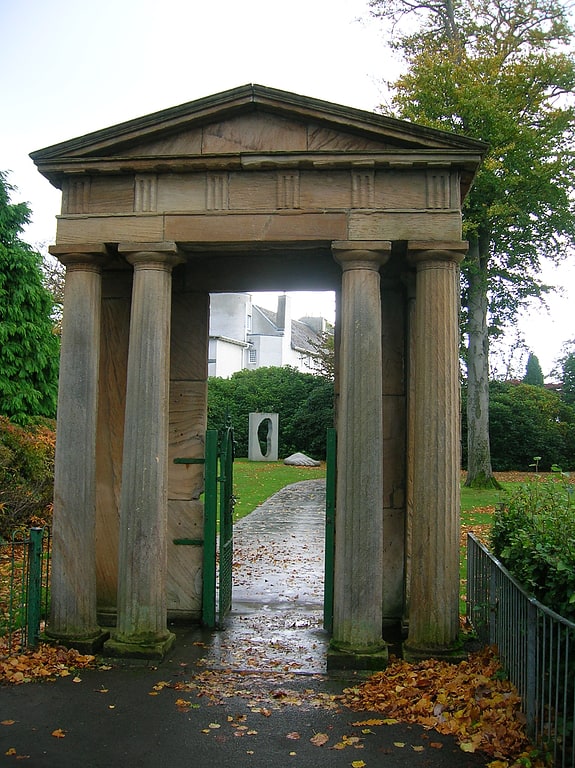
Park in Glasgow, Scotland. Bellahouston Park is a public park in the Bellahouston district on the South Side of Glasgow, Scotland, between the areas of Craigton, Dumbreck, Ibrox and Mosspark covering an area of 71 hectares. The main part of Bellahouston Park was acquired by Glasgow Corporation in 1895 for the sum of £50,000, and opened to the public in 1896. Three years later, the city's second municipal golf course was established at Bellahouston, following the success of the course at Alexandra Park. The park was extended in 1901 by the addition of a part of Dumbreck Lands purchased for £2,824 from Sir John Stirling-Maxwell. A further addition was made in 1903, at a cost of £40,222, by including the lands of Ibroxhill, from which commanding views of the city are available.
In 1938 the Empire exhibition was held at the park. The site took fourteen months to build. The price of admission was one shilling, and 12.5 million visits were recorded. The exhibition made a loss of £130,000. Of the 200 palaces and pavilions that were built for the exhibition, only the Palace of Art remains. It now serves as a Sports Excellence Centre. A stone Peace Cairn built for the exhibition is still visible from the rock garden.
In 1996 Charles Rennie Mackintosh's House for an Art Lover was completed from original drawings of 1901, and now serves as centre for the visual arts. It is based around Bella hill, created for the great Empire Exhibition. It has commanding views over most of the city, although views to the east are obscured by trees, and those to the south by hills in Mosspark. Views include that of Ballageich (Balagich) hill, rising to 1,084 feet (330 m) on the southern horizon in East Renfrewshire.[26]
Address: Mosspark Boulevard, G4 1 5 Glasgow (South Side)
SEC Armadillo

Auditorium in Glasgow, Scotland. The SEC Armadillo is an auditorium located near the River Clyde, in Glasgow, Scotland. It is one of three venues on the Scottish Event Campus, which includes the SEC Centre and the OVO Hydro.[27]
Address: Glasgow, Finnieston Street, Glasgow, G3 8YW, Scotland
Kelvingrove Park
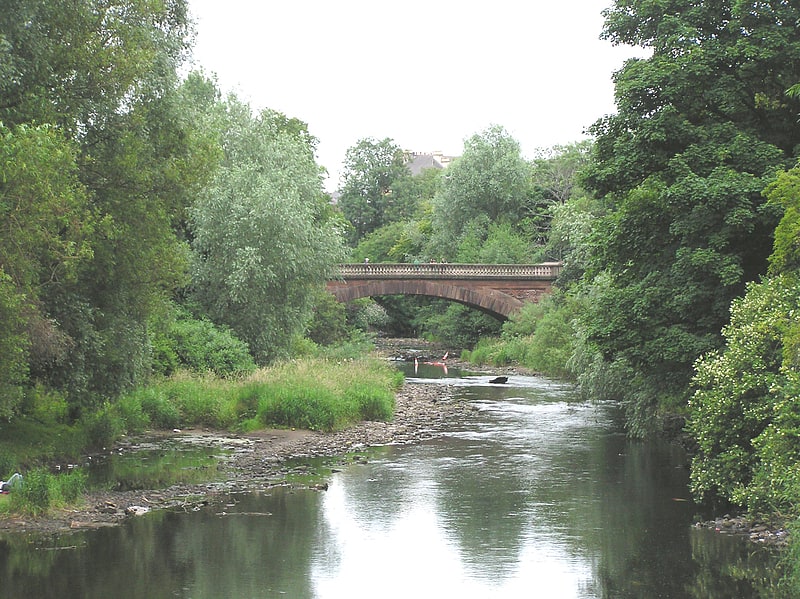
Old park with bandstand and amphitheatre. Kelvingrove Park is a public park located on the River Kelvin in the West End of the city of Glasgow, Scotland, containing the Kelvingrove Art Gallery and Museum.[28]
Address: 14 Parkgrove Terr, G3 7SD Glasgow (West End)
Duke of Wellington Statue
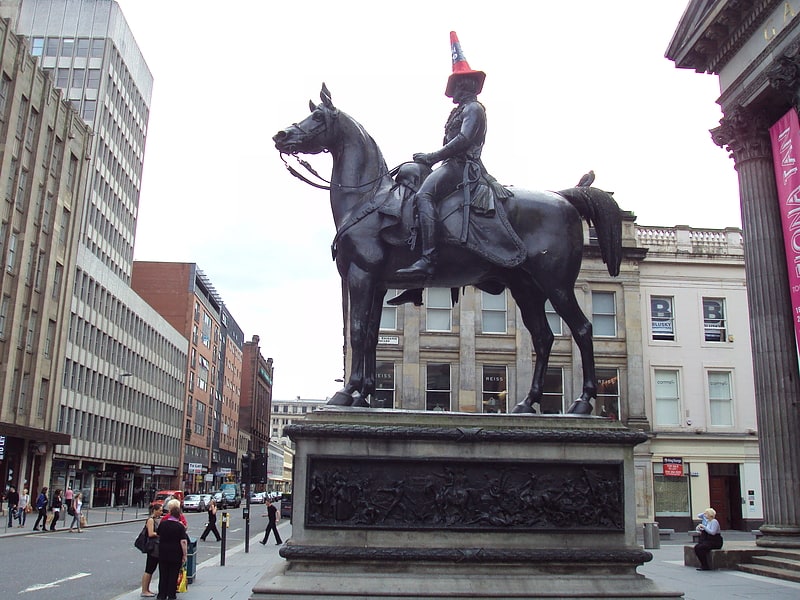
Statue by Carlo Marochetti. The equestrian statue of Arthur Wellesley, 1st Duke of Wellington located outside the Gallery of Modern Art, Glasgow, Scotland, is one of Glasgow's most iconic landmarks.
Sculpted by Italian artist Carlo Marochetti and erected in 1844, it is notable for being typically capped with a traffic cone, a practice which has become traditional in the city, representing the humour of the local population.
In 2011 the Lonely Planet guide included the statue in its list of the "top 10 most bizarre monuments on Earth".[29]
Address: Queen St., Glasgow (City Centre)
OVO Hydro
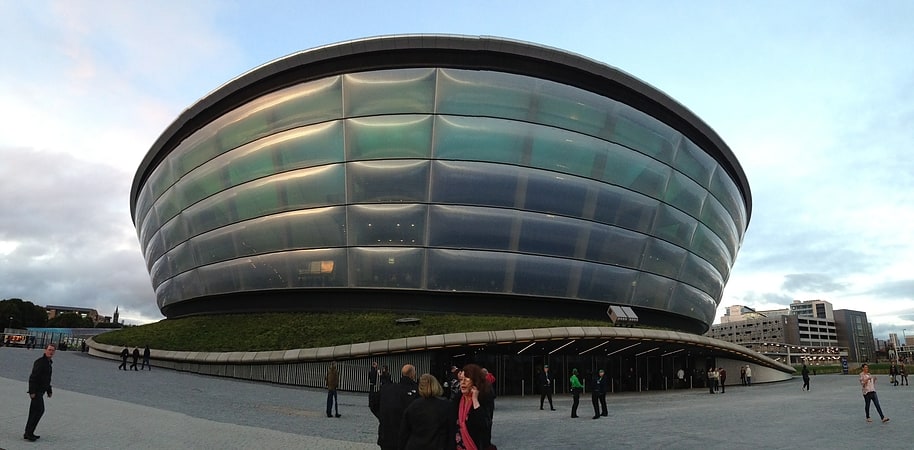
Arena in Glasgow, Scotland. The OVO Hydro is a multi-purpose indoor arena located within the Scottish Event Campus in Glasgow, Scotland, and is the largest entertainment venue in Scotland.
The arena was initially named The Hydro after its main sponsor Scottish Hydro Electric. The arena was known as The SSE Hydro until October 2021, when it was announced that the name was to change to "OVO Hydro", after its new sponsor OVO Energy, with a focus on making the venue more sustainable. The arena was officially opened on 30 September 2013, with a concert by Rod Stewart.
The OVO Hydro arena is located adjacent to the SEC Centre and the SEC Armadillo and hosts international musical stars, global entertainment and sporting events; with a capacity of 14,300 and aims to attract one million visitors each year.[30]
Address: Glasgow, Exhibition Way, SEC, Glasgow, G3 8YW
Clyde Arc
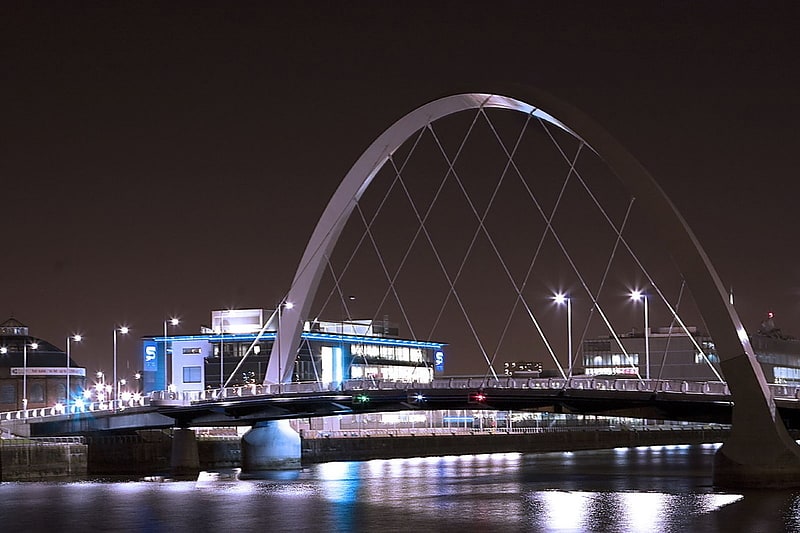
Bridge in Glasgow, United Kingdom. The Clyde Arc is a road bridge spanning the River Clyde in Glasgow, Scotland, connecting Finnieston near the Clyde Auditorium and SEC with Pacific Quay and Glasgow Science Centre in Govan. A prominent feature of the bridge is its innovative curved design and the way that it crosses the river at an angle. The Arc is the first city centre traffic crossing over the river built since the Kingston Bridge was opened to traffic in 1970.
The bridge was named the "Clyde Arc" upon its official opening on 18 September 2006. It has been previously known as the "Finnieston Bridge" or the "Squinty Bridge".[31]
Address: Govan Rd., Glasgow (South Side)
Finnieston Crane
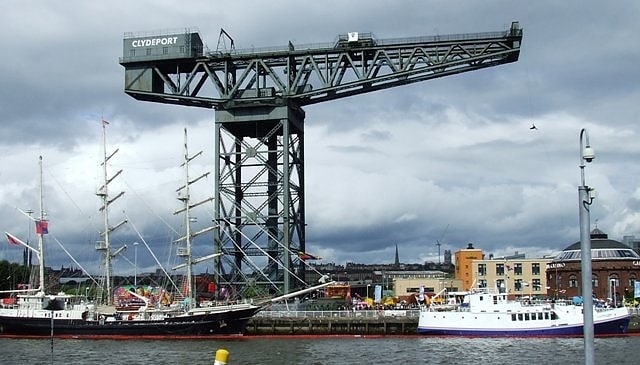
Historical landmark in Glasgow, Scotland. The Finnieston Crane or Stobcross Crane is a disused giant cantilever crane in the centre of Glasgow, Scotland. It is no longer operational, but is retained as a symbol of the city's engineering heritage. The crane was used for loading cargo, in particular steam locomotives, onto ships to be exported around the world.
It is one of four such cranes on the River Clyde, a fifth one having been demolished in 2007, and one of only eleven giant cantilever cranes remaining worldwide. The crane can be seen in the background of news broadcasts from BBC Pacific Quay.[32]
Camphill Queen's Park Baptist Church
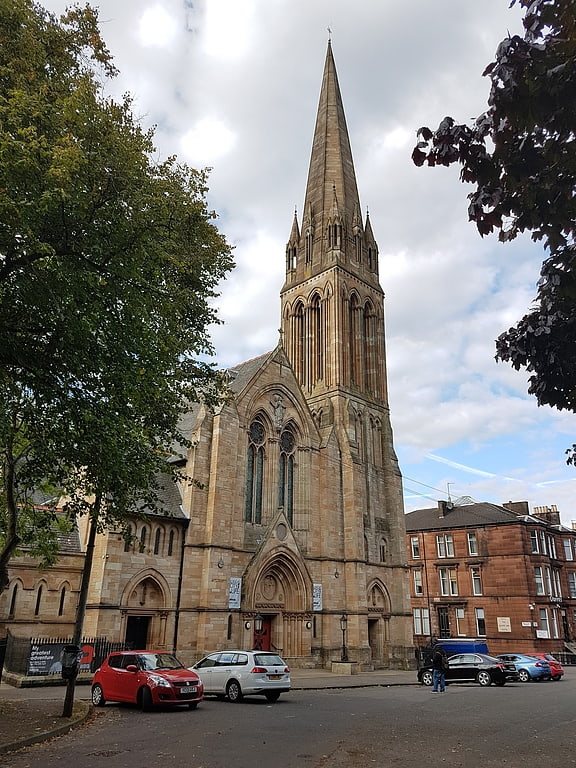
Church building in Glasgow, Scotland. Camphill Queen's Park Baptist Church is a 19th-century church building in the south-side of Glasgow, immediately opposite Queen's Park.
It was built in the French Gothic style, on designs by William Leiper. The church hall was built in 1873, while the church was completed by 8 October 1876. The octagonal church spire was completed in 1883.[33]
Cineworld Glasgow
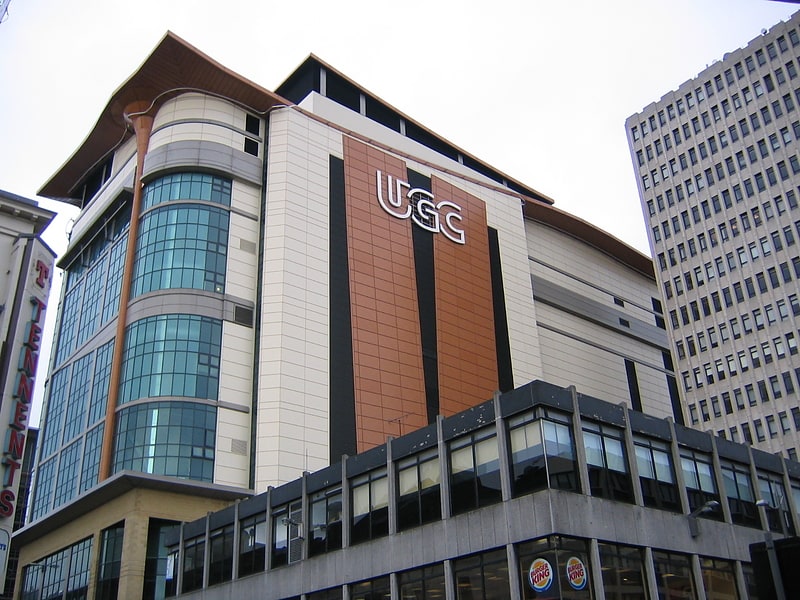
Movie theater in Glasgow, Scotland. Cineworld Glasgow Renfrew Street is a cinema on Renfrew Street, Glasgow, located in the north-east of the city centre. It is adjacent to Buchanan Bus Station and the Glasgow Royal Concert Hall, as well as being close to Sauchiehall Street and Buchanan Galleries. At 62 metres high, the building is currently the tallest cinema in the world.
By 2003 it was the busiest cinema in the United Kingdom by admissions, having attracted over 1.8 million patrons that year. Cineworld Glasgow has 18 screens over 6 levels, and can accommodate more than 4,300 people. Its most distinctive feature is the huge glass curtain wall on the east face, which houses a system of criss-crossing escalators which are lit neon blue at night.[34]
Address: Glasgow, 7 Renfrew Street
St Andrew's Cathedral

Restored 1816 Catholic church and artworks. The Metropolitan Cathedral Church of Saint Andrew or Glasgow Metropolitan Cathedral is a Roman Catholic Cathedral in the city centre of Glasgow, Scotland. It is the mother church of the Roman Catholic Archdiocese of Glasgow. The Cathedral, which was designed in 1814 by James Gillespie Graham in the Neo Gothic style, lies on the north bank of the River Clyde in Clyde Street. St Andrew's Cathedral is the seat of the Archbishop of Glasgow, currently sede vacante. It is dedicated to the patron saint of Scotland, Saint Andrew.[35]
Address: 196 Clyde St, G1 4JY Glasgow (City Centre)